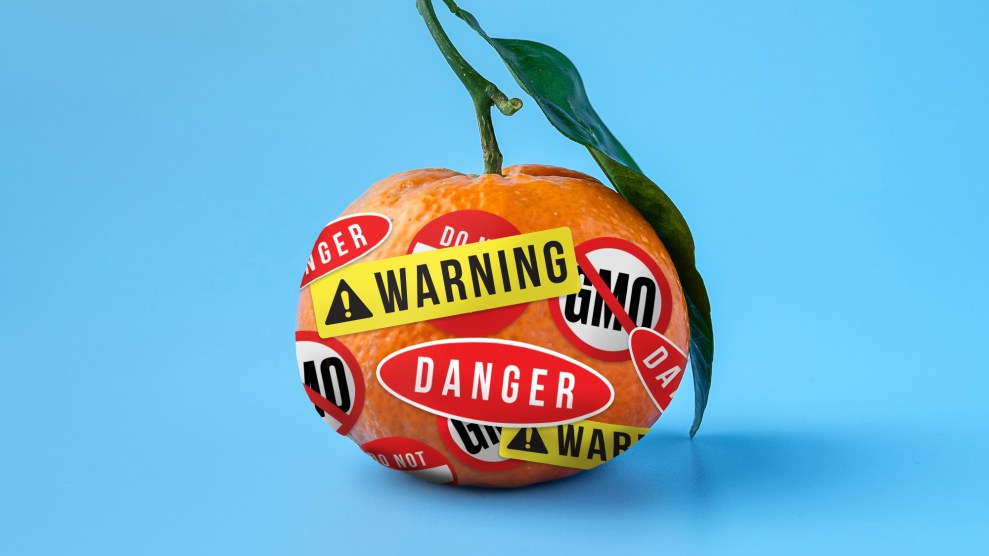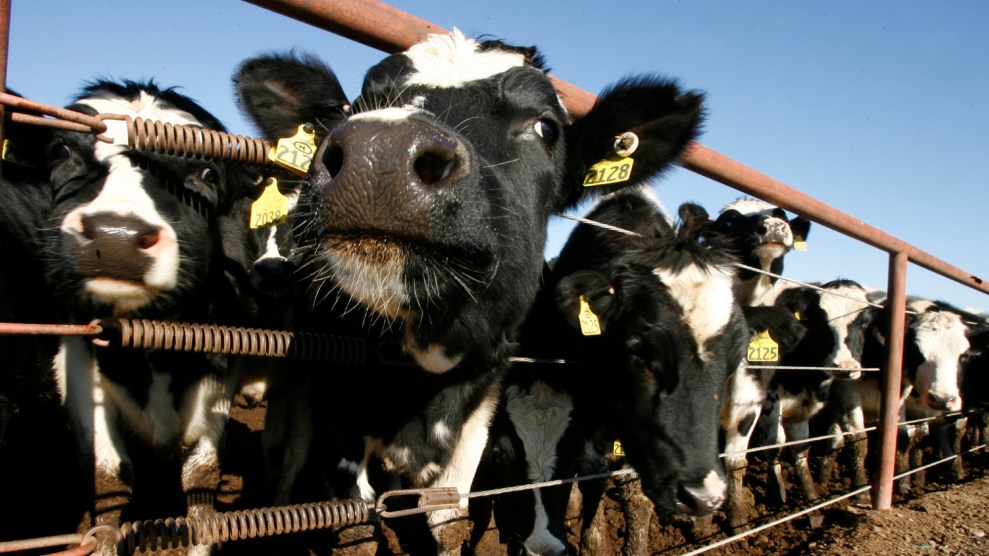
Mother Jones; Unsplash; Getty
Last month, the American Academy of Pediatrics issued new guidelines for doctors fielding parents’ questions about the risks of foods containing genetically modified ingredients. Given the morass of GMO misinformation on social media, the report was an opportunity for experts to set the record straight on how pediatricians should advise their patients on a very thorny question: Is it safe for kids to eat foods that contain GMOs?
But soon after the report was published, critics began to point out what they saw as major shortcomings: They alleged that the authors undersell the benefits of GMOs, overstate the benefits of organic and non-GMOs, and conflate concerns about genetically modified foods with worries about the cancer risks of herbicide exposure. Others noted that the report’s recommendation of organic food for people who want to steer clear of GMOs discounts the many caregivers who can’t afford it.
There is a more sympathetic way to interpret the AAP’s message: Michael Eisen, a professor of genetics and development at the University of California-Berkeley, said he saw the report taking “as a given that some parents may want to avoid GMO foods and offers some guidance to physicians as to how to support them in this.” That reading seems in line with what the authors intended. Steven A. Abrams, a lead author of the report and a professor of pediatrics at the University of Texas-Austin’s Dell Medical School, noted that he and his co-authors “make no statement that GMOs themselves are unsafe.” Rather, he said, “We recommend a discussion with families about their choices in light of the uncertainty.”
But others I spoke with thought the guidance fell short precisely because it overstated that uncertainty. “I worry that this report adds to the fearmongering and unnecessarily complicates food consumption,” Timothy Caulfield, a public health and law policy professor at the University of Alberta, wrote in a comment to Mother Jones. He noted that surveys have found that GMOs are “the topic where there is the biggest gap between scientific experts, who view GMOs as safe, and the public, a majority of whom have concerns about safety.” That gap for GMOs is larger than those for other polarizing topics, such as vaccines and climate change. For that reason, said Caulfield, “I wish the report was clearer about what the evidence says about safety and science.”
So what does the evidence say about the risks of consuming GMOs? According to nearly all agencies around the world that have looked into this issue, including the US Food and Drug Administration, the National Academies of Science, Engineering, and Medicine, the American Association for the Advancement of Science, and the World Health Organization, genetically engineered foods are safe to eat. Those conclusions are based on reams of research: Genetically modified foods are the most scientifically studied crops in history. The AAP authors do acknowledge that two National Academy of Sciences studies “reviewed the safety of GMO food crops in the early 2000s” and found no specific dangers, but they gloss over the fact that there is a resounding scientific consensus on this point.
The authors also assert that “we currently have no evidence for a benefit to GMO usage internationally.” That’s a strange point to bring up in the context of a report aimed at doctors advising American parents, but since it’s in there, let’s consider it. Danielle Shine, a registered dietitian in Australia who studies nutrition misinformation, pointed out that the AAP’s argument flouts decades of research showing that genetic engineering “allows for more food to be grown and more people to be fed worldwide.” In 2018, a review of 21 years of data published in Nature showed that genetically modified corn crops delivered up to 25 percent higher yields than conventional while also reducing incidence of fungus and other contaminants. A 2014 analysis in the journal PLoS One found that genetic modification of crops on average “has reduced chemical pesticide use by 37 percent, increased crop yields by 22 percent, and increased farmer profits by 68 percent.”
Those gains have not come without risk. The AAP report notes that as GMOs have proliferated, so has use of the herbicide glyphosate—more commonly known by its brand name, Roundup. The authors note that most of the research on the safety of consuming GMOs hasn’t looked at the dangers of exposure to the chemicals they require in order to thrive.
This is important to get into. Many of the parents who ask pediatricians about the dangers of glyphosate in food may have heard about the issue back in 2018, when the Environmental Working Group, an advocacy organization that monitors what it considers to be unwholesome ingredients, published a report that found traces of glyphosate in popular kids’ cereals such as Cheerios. That report made the rounds in the media—even as it was broadly criticized by scientists who noted that the amount of glyphosate that the group found in food was so little that it wasn’t clinically relevant.
Still, the report advises that there is reason to worry because the World Health Organization’s International Agency on Research for Cancer has designated glyphosate a “probable human carcinogen.” That’s true, but the AAP leaves out important context: the IARC is essentially the only agency that has labeled glyphosate as a potential carcinogen. In a review released in 2020, the EPA found that glyphosate is “unlikely to be a human carcinogen.” The European Food Safety Authority came to the same conclusion, as did the European Chemicals Agency and the United Nations’ Food and Agriculture Organization. The experts I talked to worried the authors’ reliance on one opinion could lead to confusion. UC-Berkeley’s Eisen said he found this imbalance troubling, but not surprising. “I no longer expect people, even scientists, to have balanced and scientifically informed views about genetic modifications and their risks and benefits,” he wrote.
The AAP authors sent me additional studies that they said bolstered their argument about the dangers of glyphosate, but the research they cited focused on high exposure levels—the kinds of doses one might receive as a farmer who works with the pesticide every day. That’s extremely important data to consider, but it’s not the same as studying exposure to the trace amounts of glyphosate present in children’s food. Caulfield said that he agreed with the authors on the need for rigorous monitoring and research on the risks of herbicide exposure, especially for farmers. But, he said, “the report seems to merge concerns about herbicides as a way of condemning GMOs more broadly.”
So what should parents do if they are concerned about their children’s consumption of genetically engineered foods and traces of glyphosate? AAP recommends that pediatricians advise them to minimize their risk by “focusing on a dietary pattern of primarily whole, plant-based foods,” especially those certified as organic, while minimizing ultra-processed foods. The group extends its guidelines beyond just parents, suggesting that “schools and hospitals dedicated to the care of children can consider avoiding serving GMO foods to minimize glyphosate exposure when alternatives are available and affordable.”
Shine, the dietitian, said she worries that the AAP guidance could lead parents to make expensive and unnecessary choices in grocery stores—or avoid buying fruits and vegetables altogether. “Over time, this may lead to an unbalanced dietary pattern, numerous nutrient deficiencies and/or disordered eating,” she said. Clancy Harrison, a dietitian who focuses on food security, worried about feelings of guilt among caregivers “who might not be able to afford foods that come out of the recommendation.”
Abrams, the lead report author, pushed back against that interpretation. “We do not indicate that concerns [about GMO safety] override financial concerns,” he wrote to Mother Jones. “We do not specifically advocate for organic, only indicate it is one way to assure non-GMO content.”
In the coming years, the conversations around GMOs will likely intensify—and as the battle over vaccines has shown, the ramifications of any muddled messaging could extend far beyond pediatricians’ offices. Already, the GMO debate has taken on geopolitical significance—there is strong evidence, for example, that Russian operatives have leveraged misinformation about genetically modified crops to sow political discord. Especially because of these high stakes, Shine said she was disappointed that the AAP missed an opportunity to send the one message she thinks would have been most helpful: “Ultimately, there is no credible evidence to support the narrative that GMO foods pose risks to human health.”

















